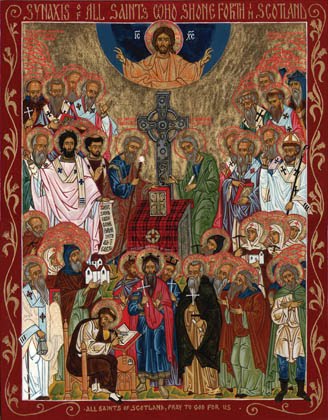
The precise date of his birth is unknown; however, Columban was born around 540 AD (some suggest 559) in Ireland, to a noble family. He received a good classical education and decided early, although the pretty Irish girls were not without some attraction to him, to embrace the ascetic life.
Columban learned how to read the psalter at the age of six. His ability to tame animals revealed his closeness to nature. As a young man he would often visit a recluse whose wisdom he appreciated. This was what determined his vocation. He decided to embrace the religious life. He walked to the Abbey at Cluaninis where he was under the tutelage of the Abbot Sinell. Later, he went to Bangor, in Northern Ireland under Abbot Congall. Columban delighted in the severity of the daily offices and in the innumerable ascetic exercises, like fasting totally for several days, praying with arms outstretched in cold water…he was called to the priesthood before leaving, with twelve monks, to evangelise the pagan regions of Gaul. The faith was there but greatly ignored and the country was constantly torn by war. Sigbert gave them authority to found a monastery at Annegray which was soon engulfed by people seeking healings and asking for the brothers' prayers. A chorus of praise celebrated Columban. Desiring to escape the popularity, he found a cave like place for retreat. As it was already inhabited by a bear, he simple asked it to go.
His disciples were becoming numerous, Columban therefore searched for a new foundation. He discovered Luxeuil some miles away. The monks created a place to mirror the monastery at Bangor. The novices flowed, it was necessary to create a new foundation for them. Columban chose a rich terrain, full of sources, which he named Fountaines. One day a contagious malady struck the monks of Luxeuil. Columban visited the sick and ordered them to rise and go thresh the wheat. All who obeyed were cured, but the disobedient struggled for a year in pain. Columban directed three abbeys: Annegray, Luxeuil and Fontaines, where, together, three hundred monks lived. The king Theodebert asked him to evangelise the countries of the Rhine. Having arrived at Bale, the monk Urcisin was despatched from the community and later founded the Abbey of Saint Ursanne in the Jura. Expelled by the Celts, driven out of Tuggen, the community then headed East, to Austria, and settled at Bregenz.
After the death of king Theodebert, the country became dangerous. Columban resolved to leave for Bregenz, and took the shortest route to Italy. Only Gall, suffering from fever, wished to remain. Columba authorised this but forbade him from saying Mass. Therefore, he left Gall in Switzerland. Overcoming many obstacles in the Alps, he settled at Bobbio, near Milan. He rebuilt the ruins, cleared the undergrowth and prepared the ground. In spite of age and fatigue, Columban worked and heaven rewarded his courage.
Overcome with infirmities, spent and tired, he died on the 23rd of November, 615 at Bobbio, surrounded by his monks, at the age of 75. Many of his disciples founded monasteries which covered Europe.
Saint Columban’s feast day is November 23rd

No comments:
Post a Comment